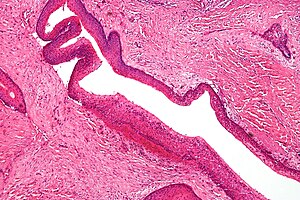Odontogenic keratocyst
(Redirected from KOT)
Jump to navigation
Jump to search
| Odontogenic keratocyst | |
|---|---|
| Diagnosis in short | |
 Keratocystic odontogenic tumour. H&E stain. | |
|
| |
| Synonyms | odontogenic keratocyst (old term) |
|
| |
| LM | stratified epithelium with "ribbon-like appearance" with palisaded basal cell layer, parakeratosis, artefactual separation of epithelium from the basement membrane |
| LM DDx | odontogenic cyst (dentigerous cyst), squamous cell carcinoma |
| Site | usually mandible - see odontogenic tumours and cysts |
|
| |
| Syndromes | nevoid basal cell carcinoma syndrome |
|
| |
| Signs | mass lesion |
| Prevalence | uncommon |
| Clin. DDx | ameloblastoma |
| Odontogenic keratocyst | |
|---|---|
| External resources | |
| EHVSC | 10179 10178 |
| Wikipedia | keratocystic odontogenic tumour |
| Pathology Outlines | topic/mandiblemaxillakeratocyst |
| Rosai Collection | 14023 |
Odontogenic keratocyst, abbreviated OKC, is an uncommon odontogenic cyst.
It was known as keratocystic odontogenic tumour, abbreviated KOT, from 2005 to 2017.[1][2]
General
- May be associated with nevoid basal cell carcinoma syndrome.
- Very rarely transforms to a squamous cell carcinoma.[3][4]
Clinical
Features:[5]
- Most common presentation: swelling.
Gross
- Location: usually mandible.
- May mimic ameloblastoma radiologically.
Microscopic
Features: [6]
- Stratified epithelium (resembling squamous epithelium) with:
- "Ribbon-like appearance" - important.
- Typically 8-10 cell layers thick - with relatively uniform thickness.
- Lacks rete ridges.
- Palisaded basal cell layer.
- "Ribbon-like appearance" - important.
- Parakeratosis (keratinized cells with nuclei) - key feature.
- Artefactual separation of epithelium from the basement membrane.
DDx:
- Odontogenic cyst.
- Orthokeratinized odontogenic cyst[7] - usu. dentigerous cyst - has orthokeratosis instead of parakeratosis.
- Orthokeratosis = keratinized cells no nuclei; parakeratosis = keratinized cell with nuclei.
- Orthokeratinized odontogenic cyst[7] - usu. dentigerous cyst - has orthokeratosis instead of parakeratosis.
Images
www:
Sign out
Right Maxillary Sinus Mass, Excision:
- Consistent with odontogenic keratocyst (benign ribbon-like squamous epithelium
with keratinization, separated from the underlying hyaline stroma with cartilage).
- Benign respiratory mucosa with mild inflammation.
- NEGATIVE for malignancy.
See also
References
- ↑ Madras, J.; Lapointe, H. (Mar 2008). "Keratocystic odontogenic tumour: reclassification of the odontogenic keratocyst from cyst to tumour.". J Can Dent Assoc 74 (2): 165-165h. PMID 18353202.
- ↑ El-Naggar, Adel K, ed. (2017), WHO Classification of Head and Neck Tumours, WHO/IARC Classification of Tumours, 9 (4th ed.), Lyon, France: IARC Press, ISBN 978-92-832-2438-9, http://publications.iarc.fr/Book-And-Report-Series/Who-Iarc-Classification-Of-Tumours/Who-Classification-Of-Head-And-Neck-Tumours-2017.
- ↑ Lee, JW.; Gates, R.; Wignall, A. (Aug 2011). "Squamous cell carcinoma arising from a keratocystic odontogenic tumor.". Otolaryngol Head Neck Surg 145 (2): 356-7. doi:10.1177/0194599811399270. PMID 21493332.
- ↑ Tan, B.; Yan, TS.; Shermin, L.; Teck, KC.; Yoke, PC.; Goh, C.; Balakrishnan, A.. "Malignant transformation of keratocystic odontogenic tumor: Two case reports.". Am J Otolaryngol 34 (4): 357-61. doi:10.1016/j.amjoto.2013.01.002. PMID 23374486.
- ↑ Habibi, A.; Saghravanian, N.; Habibi, M.; Mellati, E.; Habibi, M. (Sep 2007). "Keratocystic odontogenic tumor: a 10-year retrospective study of 83 cases in an Iranian population.". J Oral Sci 49 (3): 229-35. PMID 17928730.
- ↑ Thompson LDR. Head and neck pathology - (Foundations in diagnostic pathology). Goldblum JR, Ed.. Churchill Livingstone. 2006. ISBN 0-443-06960-3.
- ↑ Macdonald-Jankowski, DS. (Dec 2010). "Orthokeratinized odontogenic cyst: a systematic review.". Dentomaxillofac Radiol 39 (8): 455-67. doi:10.1259/dmfr/19728573.
- ↑ URL: http://www.sciencedirect.com/science/article/pii/S0968605305000992#fig5. Accessed on: 11 March 2013.



